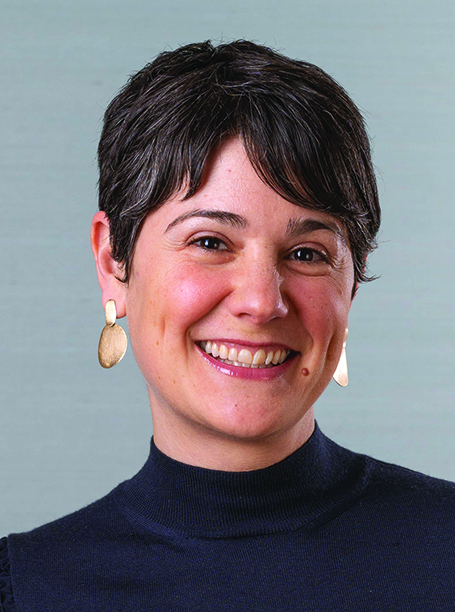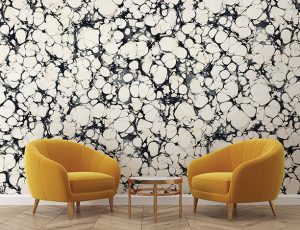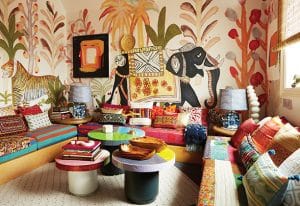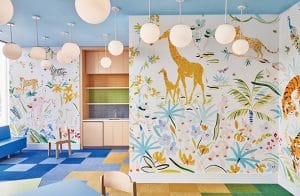Kyra Hartnett
Co-founder, twenty2 wallpaper and textiles, Litchfield, Connecticut
“Kyra is a true leader who not only aims to support the community, but to create a company with a supportive, educational culture. She propels the wallpaper, and now fabric, industry forward by creating a private-label, environmentally sustainable product sold by more than 100 businesses.” — Lela Ilyinsky, associate, twenty2 wallpaper and textiles
HAS THERE BEEN an enthusiastic response to digital printing from your clients?
It’s been pretty incredible. When we offered this to a few colleagues seven years ago, we said, “You know, if you have any thoughts about wallpaper (there were people who were doing textiles or carpets already), we’d be happy to work with you, and I think we could create some great products together.” And the response was so overwhelming that honestly, year over year, our business has just boomed. Seven years ago, we had one printer and it was just my husband and myself. There’s now 20 employees who work for us and we’ve expanded into digital textile printing, as well. We’re really incredibly fortunate to have helped so many designers understand. And these are designers who might have been making traditional wallpaper since the 1800s or an independent designer in Brooklyn who just started making wallpaper. So really we have the privilege of working with the full spectrum of customers.
Advertisement
What does it mean to be a woman in the wide format digital printing industry?
I’m so proud to be a woman in this industry. Our team, which is now 20 people, 18 of us are women so we are an incredibly powerful group of hardworking, creative, passionate women who are lifting huge bolts of wallpaper and printing on these incredibly sophisticated machines, so it’s really empowering. I grew up with a very politically active family. My mother was a Civil Rights activist; she became a lesbian when I was a child, so I definitely had a very open and politically diverse upbringing. The power of being a women was something that was really instilled in me at a very young age and I’m really, really proud to be able to employ as many women as we do in this male-dominated industry. There’s scientific data on how women see color differently and better than men do, so particularly in our industry where we really pride ourselves on our artful color management and color accuracy of the products we produce, we feel really lucky to have these incredibly talented women working with us. I have two young daughters and I’m proud to be setting the example that I am as a business owner and as a mentor for people in the industry.
Our approach has been that we don’t necessarily look to hire people who have wide-format experience; we look to hire people who are artists, surface designers, and print makers. There’s almost more women than men who are going to art school to pursue those careers. But then, it’s hard to find a tangible career to apply those skills to, so we’ve really found that having that sharp eye and understanding the beauty of art is what makes a good employee for us. We can teach the wide-format printing onsite; that’s on the job training. Some of our employees might have worked in the print shop at their college and helped other people print their work for their courses, but we rarely look into our industry to hire. We really look for people who are artists themselves. For our employees to understand the value of the process is important. We’re making our customers dreams come to life. There might be someone who doesn’t know how to make wallpaper who might have envisioned this for their future for a decade before finding the right manufacturing partner, so we’re really helping make those dreams come true. Our employees coming from artistic backgrounds really helps them facilitate those dreams and helps them take great pride in what they’re doing.
PHOTO GALLERY (4 IMAGES)
Can you talk about the process of digitally printing wallpaper for high-end environments and why you chose to use wide-format machines versus traditional rotary printing?
My husband [co-founder] and I actually started as wallpaper designers in the early 2000s. We came from a retail store display background, so digital media was what we knew and enjoyed. When we decided to create a product for high-end home décor, at that time, digital printing just wasn’t there in terms of image quality, hand-feel, and the materials that could be printed on. We really needed to put our digital dreams aside until technology caught up with us. We fell in love with hand screen printing. We had a contract manufacturer in New Jersey that printed our collections for about a decade, but we really kept our eye on digital technology because we knew that was the future of design.
Advertisement
About seven years ago we really started doing some tests. We saw there were some things coming out of HP, in particular, that were ecofriendly as well as really beautiful in their image quality. The ecofriendly aspect was critical to us; we just were not interested in solvent-based inks or UV or anything that was harmful to the environment. So we jumped in with our first small HP wide-format printer (small compared to the ones we’re using now), our first baby latex as we call it, and we immediately fell in love with the possibilities. The limitations were completely lifted. We had repeat size, image, number of colors – all of the limitations we had become accustomed to with screen printing just evaporated. We were so excited by the possibilities. And at that time we decided we were excited enough that we wanted to offer those services to colleagues in the industry.
So rather than focusing on using the machine we purchased to further our own design pursuits, we really felt like it was the perfect time to translate everything we had learned over a decade as designers as well as customers of manufacturers. We felt like we could meld that into an experience that was unlike any other manufacturing experience that we had, so very design-focused, very much focused on environmental solutions that were not harmful to the environment, and very full-service. We were now all of the things we wished our manufacturers could have done for us under one roof: a full-service design studio where designers often bring us a stack of original fine art paintings and they say “I know these would make incredible wallpapers, but I just don’t know how to do it.” So, we photograph the artwork, we digitize, we present repeats solutions whether they’re murals or standard repeats and then we take it all the way through to a showroom rollout where we’re creating memo samples for them, we’re drop shipping products to different showrooms, and then on an ongoing basis everything is made to reorder. We’re drop shipping directly to the end user so we’re trying to minimize waste and minimize the need for our customers to hold inventory, so we’re really trying to revolutionize the way that business in done in the most environmentally responsible way, and the most creative way in terms of technology.
Has there been an increase in printing for the interior décor market during the pandemic?
We’ve seen continued growth during this time. I think people really are understanding the value of their homes and obviously spending a lot more time in their homes, creating multi-purpose spaces that might need to be an office and an exercise room. And so definitely things have continued to grow. And we're really excited to be a part of that.
All of the wallpaper printed at twenty2 is done so responsibly and sustainably by using water-based, earthy-friendly inks, eco-friendly grounds. Can you explain the importance of sustainability in your shop and the industry?
Ever since we started in the early 2000s with wallpapers, we were very conscious of the impact on the environment, it’s a core value that my husband and I have had since we started our business almost 20 years ago. And that was hard in the screen printing world. It was sort of just moving in the direction of water-based inks. And so we had to hop around to a couple of different manufacturers to really get someone who could produce the product that we wanted as beautifully as we needed with an ecofriendly platform. So with digital printing, that was imperative. We just were not going to get into the industry if we couldn't do it responsibly.
Advertisement
We were thrilled to find HP as a partner with their water-based solutions. And we only print on grounds that are biodegradable and recyclable, so we don't print on vinyl, which, as you likely know, is a huge part of the commercial wallcovering industry. So again, we’re really happy to find products that are certified Type II, suitable for commercial environments from a durability and cleanability perspective, but are not vinyl. We can quite confidently help people move forward in their thinking. And it's still often specified Type II vinyl. But we talk people through the attributes of the products that we offer and we feel now, after seven years of using them, we can speak really confidently to how well they hold up. We’re really proud to be pulling people along. I think in the home decor, in the high-end homes, that's not as challenging, but certainly in the commercial projects to convince people that, yes, this is suitable, even though it's not vinyl.
It’s a challenge that we take on wholeheartedly. And we're really proud to be having those conversations. And the same is true with our textile printing. There are options that are much less ecofriendly. Textiles in general tend to be very water consumptive, and 20 percent of the world's water pollution comes from the textile industry. So we knew that we could not get into that side of our business and be contributing to that problem. So we're really thrilled with the technology that we're moving forward with textiles because it doesn't use water. The inks are eco-friendly. The grounds we're printing on are very sustainably produced. So we're able to really move forward confidently into that category, as well. We’ve transformed all of our packaging materials because we dropship directly to the end user, as I mentioned. So we now use biodegradable, sustainable, recycled packaging for everything that leaves our shop. So we are very committed to it across the board.
Design Credit: Rule of Three Studio
Photo Credit: Liz Goldwyn, Design Credit: Maison C
Photo Credit: Rachel Robshaw, Design Credit: Caitlin McGauley
Photo Credit: Rachel Robshaw, Design Credit: John Robshaw & Sara Bengur


 Best of Wide Format2 months ago
Best of Wide Format2 months ago
 Columns2 months ago
Columns2 months ago
 Best of Wide Format2 months ago
Best of Wide Format2 months ago
 Blue Print2 weeks ago
Blue Print2 weeks ago
 Best of Wide Format2 months ago
Best of Wide Format2 months ago
 Best of Wide Format2 months ago
Best of Wide Format2 months ago
 Best of Wide Format2 months ago
Best of Wide Format2 months ago
 Best of Wide Format2 months ago
Best of Wide Format2 months ago

























